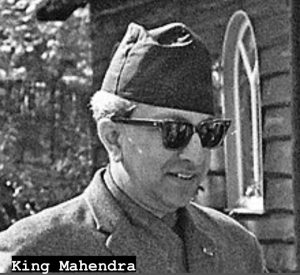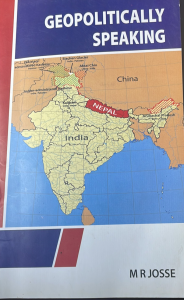“Now, let’s examine Nayak’s assertion: “India and Nepal were both part of the colonized sectors of the British East Indian Company.” Not so, madam! As far as Nepal is concerned, she at times fought valiantly and ferociously against the Company; subsequently, she even militarily assisted in the quelling of the 1857 Sepoy Mutiny. That ultimately led to the formal takeover of all Indian territories by the British Crown, with India becoming part of Britain’s Empire”.
################################################
M. R. Josse
Former Editor-in-Chief
The Rising Nepal, Kathmandu. Nepal

The other day, I came across a write-up – “India and Nepal’s Kalapani border dispute: An Explainer”- which, inter alia, contained this chunk of egregious claims: “Given that Nepal is a buffer state between the two other countries – both with great power aspirations in the region.
That supposedly carefully researched paper continued and, without batting an eyelid, gushed: “India and Nepal were both parts of the colonized sectors of the British East India Company.”
Geopolitical Primer:
Normally, I would have dismissed the ‘explainer’ as a product of sheer ignorance had I not noticed that it was published last month, authored by Sohini Nayak – and, significantly, bore the imprimatur of the New Delhi-based Observer Research Foundation, whose official website rather grandly describes its ‘mandate’ as follows:
“ORF seeks to lead and aid policy thinking towards building a strong and prosperous India…ORF helps discover and inform India’s choices.
It carries Indian voices and ideas to forums shaping global debates.”
As far as I am aware, ORF, established in 1990, is an avant-garde think-tank considered quintessentially ‘Establishment’ -sans such an official label!
Hence, it’s simply astounding that Nayak should, in this day and age, claim that Nepal is merely a “buffer state” between India and China, almost as if such a geopolitical status was
Nepal’s raison d’etre.
She seems to forget, or ignore, that the 17th century colonial concept of buffer states has long gone the way of the dodo, as even states situated uncomfortably between two rival and potentially hostile powers often possess all the customary attributes of state sovereignty; participate actively in the affairs of the global community; and, very often, even adopt foreign policy positions at odds with that of her puissant neighbours.
Briefly, let me now recall a few hard facts of history and geopolitics as they relate to Nepal. Long before colonial India became free India, Nepal had at periods in her past swept through and conquered significant swathes of what is Indian territory today, bringing her into conflict with the British East India Company. At other times, she engaged in war with Tibet/China. Some “buffer”, what?
Moreover, long before India became independent – and much before Pakistan, Bangladesh and Sri Lanka acquired the status of independent sovereign states – Nepal was so recognized by Great Britain, the Super Power of the time.
A quick reminder: “On December 21, 1923, Nepal initiated a formal treaty relationship with Great Britain that acknowledged Nepal’s status as a fully sovereign nation.
” (M.R. Josse, ‘Nepal’s Quest for Survival’, NEFAS, 2020).
“Without doubt, this helped Nepal escape the fate of 536 princely states that were absorbed by India after independence” (Ibid)… “In 1934, Nepal opened a diplomatic mission in London, her very first.” (Ibid).
Regarding the second part of the opening quotation – the assertion that both India and China possess “great power aspirations in the region” – even a dope well knows: (a) China is not only a permanent member of the U.N. Security Council, as India is not, but is today acknowledged as the world’s second Super Power, after the United States; (b)
India might jolly well aspire for great power status in the region but cannot rationally be thus bracketed, or equated, with China.
I would be remiss if I did not mention that, years before New Delhi and Beijing had functioning Israeli embassies, Kathmandu not only proudly housed such a diplomatic establishment but also engaged in a wide-ranging spectrum of state-to-state activities with Tel Aviv, including the training by Israeli Defence personnel of the Nepalese army’s first paratroop unit.
Besides, quite aside from Nepal’s membership of the United Nations – with the same status as all other member-states, apart from the ‘Permanent Five’- Nepal has twice served on the UN Security Council. An amazing achievement for a “buffer state” – don’t you think?
Now, let’s examine Nayak’s assertion: “India and Nepal were both part of the colonized sectors of the British East Indian Company.” Not so, madam! As far as Nepal is concerned, she at times fought valiantly and ferociously against the Company; subsequently, she even militarily assisted in the quelling of the 1857 Sepoy Mutiny. That ultimately led to the formal takeover of all Indian territories by the British Crown, with India becoming part of Britain’s Empire.

Also, recall: “Not only did Nepal come to the aid of the beleaguered British; Jang Bahadur and his brothers personally led troops, helped turn the tide and bought for the British Raj a precious 90-year lease of political life! Nepals Quest for Survival.
Realpolitik:
In dealings with Nepal, India practices realpolitik – practical or power politics – though, more often than not, she tries to camouflage that with claims to high moral or ethical
motivations.
Against the current backdrop of the Kalapani/Lipulekh dispute, I believe it would be most edifying to delve into the broader aspects of Indian foreign/security policy, particularly those relating to the Himalayas, Tibet and associated geopolitical issues.
In that context, mull these revealing, or even startling, insights of former Indian Foreign/Defence/Finance Minister, Jaswant Singh, as culled from his book, Defending India, (Macmillan, India Ltd., Chennai, 1999).
One set of recollections touches upon Singh’s deep dissatisfaction that allegedly Pandit Nehru’s foreign/security policy relating to the Himalayas and Tibet was laced with syrupy idealism – when it should have been infused with hard-nosed realpolitik.
“Had national security consideration aspects predominated, and had a realistic geostrategic sense about the region taken priority over emotional anti-imperialism, then Pandit Nehru could have more readily assessed that for an independent India to have an independent Tibet, as a buffer between it and an emerging China, was not only a wise precaution; it was a policy imperative.” Singh laments: “This is altogether more inexplicable when one examines the rapidity with which Nehru reacted to events in Nepal in the mid-fifties, forcefully intervening there to restore the Nepalese monarchy.
Nepal and Tibet were both Himalayan kingdoms (sic), both were of vital strategic importance to India, and they were both afflicted, almost simultaneously, whether externally or internally, and yet India and its political leadership reacted differently.
No less relevant is this coruscating excerpt bemoaning the absence of realistic geopolitical goals in India’s foreign/ security policy – one advocating hard-headed realpolitik, rather than promoting pie-in-the-sky, idealistic values.
In Singh’s words: “Just as there was an absence of Central Asian thought, the presence of the high Himalayas deluded our political leadership into a false sense of security.
It was astonishing that whereas developments in Nepal could deeply trouble Pandit Nehru, persuading him to intervene in a most marked manner; yet, another step away, developments in Tibet resulted in no reaction than one of quiet and timid acquiescence. This too can be attributed to the second failing: absence of a strategic concept about the role and place of the high Himalayas in the geopolitics of the South Asian subcontinent.”
Notably, Singh does not explain how Nehru could, in 1954, have realistically or militarily challenged a resurgent, unified China’s authority in Tibet.
Nehru was eminently sensible in recognizing – in a formal Sino-Indian agreement in 1954 – China’s authority in Tibet.
India then could not militarily prevail over the People’s Republic of China in Tibet. Remember that China had convincingly demonstrated in the Korean War – soon after its establishment on 1 October 1949 – her awesome military capabilities and humungous manpower resources.
Against the backcloth of the current border dispute – with transparent Tibet ramifications – the significance of the regional foreign/security policy adventures being planned in the ‘baithaks’ of power in India, and the carefully orchestrated and aggressive, chest-thumping tirade against China, Pakistan and Nepal by its media, should be an eye-opener.
Particularly striking is Singh’s assessment of the imperativeness of the ‘independence’ of Tibet in the Indian national interest!
I have no doubt that its significance has not been lost on Beijing, especially as India continues to host a so-called “Tibetan government-in-exile’ in Dharamsala.
I also find it most absorbing that it is Jaswant Singh of India’s ruling BJP party, and none other, who has penned such incendiary thoughts. That only reminds me of the redoubtable Rajput’s past career as an Indian Army cavalry officer.
I, for one, have long been convinced that if China had not reasserted her authority over Tibet when she did, Nepal, as an independent state, would long have withered away – a la Sikkim! Our policy wonks, wherever they are and whoever they may be, would therefore do well to factor all this in, when framing Nepal’s future India policy.
Some other tell-tale thoughts on the same subject are extant in Surjit Mansingh’s India’s Search for Power: Indira Gandhi’s Foreign Policy 1966-1982 (Sage Publications, New Delhi, 1984). Among them: “How can India be strong enough to protect its vital interests without arousing fear among its smaller neighbours? How can India be generous and tolerant of its neighbours’ difficulties without being dubbed impotent and subjected to unreasonable demands?” ‘ (p. 265).
Absorbing, too, is her assessment that “Sikkim’s importance to India was underlined by the Sino-Indian war of 1962.” By 1975, Sikkim, as we all know, was part of India!
Yet another revealing facet of Indian thinking vis-à-vis Nepal is crystallized in her comment that “Most important from India’s point of view, King Mahendra initiated friendly ties with China and Pakistan”, clearly suggesting that India would have preferred that Nepal – like Sikkim of yore and today’s Bhutan – be cut-off from all diplomatic ties in the region, barring those with New Delhi!

Against the backdrop of the prevailing media hysteria against Nepal (and China and Pakistan), it is useful to note what Mansingh, a former Indian Foreign Service officer, has to say about the birth and role of India’s separate foreign intelligence and counter-intelligence agency – named Research and Analysis Wing (RAW) – in the context of India’s foreign/security policy.
Dezinformatsiya:
As most senior members of today’s Nepal government – besides other political players – need no introduction to RAW, I would like to briefly focus at this time merely on Mansingh’s revelations (p. 291) as they pertain to Sikkim and, more so, on ‘disinformation’ on preparations for the Pokhran 1974 nuclear test.
As she frankly recounts, RAW’s long regional agenda included “counter-espionage in Sikkim and collaboration with the Sikkim Congress in eliminating the Chogyal; (and) disinformation about the Pokhran preparations.
As I have written extensively on Sikkim’s incorporation into the Union of India in my new book Nepal’s Quest for Survival, and expounded at some length recently in the pages Of this journal on the Pokhran and other nuclear tests in Sout Asia of 1998, here I will just deal with ‘disinformation’ – Or,’dezinformatsiya’ in the Russian language.
I do so for two principal reasons: one, because it was developed and refined into a fine art form in Joseph Stalin’s USSR; and the other, because for long, long years New Delhi enjoyed special, special’ relations with Moscow, including during its heyday when Indira Gandhi ruled the roost in India.
Although presently the Soviet Union and Indira Gandhi are no more, the practitioners of the arcane skills of ‘dezinformatsiya’ are very much alive and well in the mirrored halls of Edwin Luyten‘s Delhi, not to mention in Indian editorial offices, TV news studios and the groves of academe.

While Nepalese have themselves experienced the ravages wrought by Indian dezinformatsiya, including in the past fifteen years culminating in ‘regime change’ in Nepal, it had done even more so in Sikkim, as Mansingh’s confession so powerfully reminds us.
That form of statecraft has flourished in Narendra Modi’s India – a far cry from Indira’s India and Leonid Brezhnev’s Soviet Union – which today attempts to whitewash, in a blitz of dezinformatsiya, the government’s sorry economic performance, continued simmering opposition to its Kashmir policy and to a whole raft of illiberal and discriminatory legislation, not to mention, its failure on the pandemic front.
Finally, dezinformatsiya in India has blossomed into a blizzard of crazy conspiracy theories, including in ‘proving an anti-India Nepal-China-Pakistan collusion!
25 May 2020.
# Text courtesy: Geopolitically Speaking by M. R. Josse. Publisher-Periwinkle Prakashan Pvt. Ltd. Dilli Bazar Kathmandu, Nepal.
Published : September 2020:
Thanks the publisher and the author of the book: Ed. Upadhyaya.
